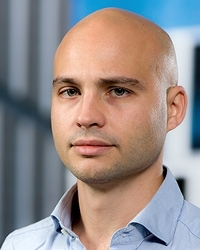A PhD position after the IE master programme

By PhD student Franco Donati
How did you experience studying Industrial Ecology?
I liked it very much! I feel I got some pretty strong tools and skills for understanding sustainability issues. The tools and skills that I learned during IE have been very valuable in my development as a researcher. Also, the community is very nice, I met a lot of great and interesting people from many different countries.
What was the topic of your thesis?
I wrote my thesis on software to model circular economy interventions in Input-Output analysis. I wrote a python application to model these interventions and process them.
With the software you can for example change the value of the amount of steel being consumed by a certain industry or substitute steel for aluminum. Afterwards, you can see how this change affects environmental impact. After my graduation I continued the development of this software which is now the focus of a paper I am submitting for publication.
Did you also do coding during your bachelor?
Actually I didn’t start coding before my master. I learned a lot about coding in Python during my thesis. During my bachelor I studied Industrial Design with a focus on sustainability. My thesis was about design and development of sustainable toys.
Can you tell me about your PhD work?
My PhD is funded by the European Union through the EIT Raw Materials KIC . The objective is to develop a web-platform and courses for analyzing and modeling raw material supply chains. So we are working on teaching material alongside the development of the platform. The idea is that the participants of the course will learn about raw material supply chains, the issues connected to themand how to simulate political and technological interventions. During the course we will discuss Life Cycle Assessment, Material Flow Analysis and Input-Output Analysis. So the course is about learning the tools and simultaneously trying to contextualize them within the circular economy. The target audience is broad, from master students to policy analysts. The platform is currently under deployment phase and we have started testing the didactic material.
The other part of my research will be focused on data mining. There are some large repositories available of 3D Computer Aided Design (CAD) models. 3D CAD models are virtual representations of products . Thesefiles contain valuable information on the composition of specific products (e.g. volumes and materials) . By combining the information from the 3D CAD models to other databases, you should be able to partially model products’ supplychains and therefore also determine the environmental impacts and material requirements. The online repositories contain millions of 3D CAD models referring to products. If you are able to process these files you could automatizethe creation of life cycle inventories of millions of products. Of course they need to be fixed for errors afterwards, but they can be very useful for people working with Life Cycle Assessment for example.
What is something you would tell current students based on your experience?
Two things: the first one is don’t give up too soon on coding. It takes some effort, but once you are getting started it is a lot of fun. The second is to make use of the opportunities you’ll get in the master program. Always look for ways to get the most out of Industrial Ecology by understanding in which way what makes you excited and interested combines with what you are learning.